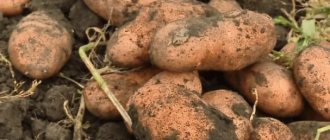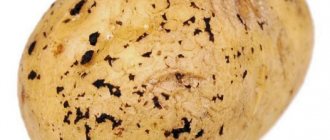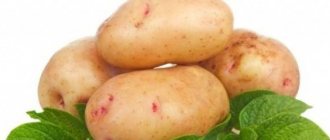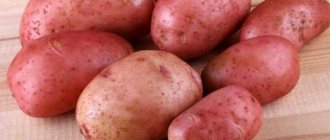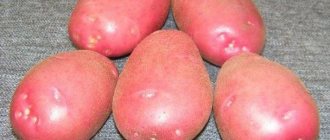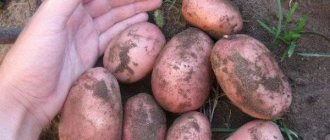The history of the origin of the potato variety "Kiranda"
In 1993, the variety was brought from China to Ukraine for the purpose of growing in large agricultural quantities. But for a number of reasons, Chinese agronomists were forced to abandon the sown fields and return to their homeland. The resulting harvest interested Ukrainian scientists. In particular, a breeder named Davydov took up the study of potatoes - it was in his honor that the variety was named: Chinese Early Davydova, abbreviated “Kiranda” .
Potatoes bred by Davydov were not included in the State Register, but became widespread through word of mouth, through the transfer of seeds from hand to hand. Kiranda has demonstrated excellent growth rates in the southern regions with hot climates.
The table below presents data on the yield of other potato varieties:
| Name | Variety | Productivity |
| Nikulinsky | Late ripening | From 170 to 300 centners per hectare. |
| Cardinal | Late ripening | From 200 to 350 centners of potatoes are harvested from 1 hectare. |
| Rocco | Late ripening | From 350 to 400 centners per hectare. |
| Kiwi | Late ripening | From 1 kg of planting tubers it reaches 20 kg. |
| Picasso | Late ripening | From 1 hectare about 20 tons. |
| Borovichok | Early ripening | 200-250 centners per 1 hectare of land. |
| Elmundo | Early ripening | 250-350 centners per hectare. |
| Felox | Early ripening | 250 centners per hectare. |
| Bellarosa | Early ripening | The harvest from one bush is 8-10 tubers. |
| Natasha | Early ripening | From 130 to 190 centners per hectare. |
| Forty days | Extra early | Up to 300 centners of potatoes are harvested from one hectare of soil. |
| Karatop | Extra early | From 18.5 to 27 tons per hectare (Middle Volga region), from 20 to 43.5 tons per hectare (Northwestern region). The maximum yield is 50 tons per hectare. |
| Riviera | Extra early | After the first digging on the 45th day after the emergence of potato shoots, it ranges from 134 to 225 centners per hectare. The maximum yield by the end of the growing season reaches 450 centners per hectare. |
| Zhukovsky early | Extra early | The harvest from one bush is up to 15 tubers. |
| Minerva | Extra early | Fertile soils allow you to harvest the first harvest of up to 230 centners per hectare. By the end of the growing season (45-50 days), the maximum yield is achieved - up to 430 centners per hectare. |
| Crane | Mid-late | 640 centners per hectare. |
| Sorcerer | Mid-late | Productivity varies from 27 to 35 tons per hectare. |
| Mozart | Mid-late | The average yield is approximately 430 c/ha. |
| Grenada | Mid-late | From one hectare you can harvest up to 60 tons of potatoes. |
| Ramona | Mid-late | The yield is consistently average from 10 to 15 tons per hectare. |
| Yanka | Mid-early | The average yield ranges from 195 to 315 centners per hectare. |
| Giant | Mid-early | The average harvest ranges from 290 to 424 centners per hectare. |
| Tuscany | Mid-early | Productivity varies from 210 to 400 centners per hectare. |
| Purple Haze | Mid-early | Productivity varies from 182 to 309 centners per hectare. |
| Santana | Mid-early | The average yield varies from 164 to 384 centners per hectare. |
Potato "Miranda": a new competitive variety
Potatoes "Miranda" are included in the State Register for cultivation in the Middle Volga region. This early ripening variety was bred by foreign breeders. Potato variety "Miranda" from the originator Saka Pflanzenzucht GBR is promising for cultivation in home gardens and small farms.
Description of the variety
The Miranda variety is an early variety: it forms a harvest in 65-75 days. Potato bushes are low or medium height. They are characterized by an intermediate type, semi-erect. The corolla is medium in size, white. The leaves are most often medium in size, but can also be large. The total yield is 113-322 c/ha.
The oval-shaped root vegetables have a smooth yellow skin. The eyes on root vegetables are very small. The average weight of one tuber can vary from 92 to 175 g. The pulp is light yellow. Starch content is approximately 16.2%. “Miranda” is a table variety that has excellent taste and high commercial qualities.
The resistance of this variety to the pathogen of potato canker, which is widespread in our country, as well as the golden potato cyst nematode, is quite high.
Landing Features
Potatoes "Miranda" are an early variety, and in order to obtain the earliest possible, but high-quality vegetable products, it is necessary to take into account a number of features when planting and further cultivation:
- Before planting, it is recommended to germinate potato tubers in the light and then grow them using a moist substrate, to which it is advisable to add mineral fertilizers.
- For planting any varieties of early potatoes, including the Miranda variety, preference should be given to the southern and elevated side of the garden plot.
- The planting density of prepared potato tubers largely depends on soil fertility and moisture, as well as varietal characteristics. However, most experts recommend planting early potatoes fairly densely.
- In central Russia, it is customary to plant early varieties of potatoes when the soil is heated to + 8° C. Average depths can vary from 8 to 15 cm, depending on the density of the soil and the size of the planting material.
Also read: Potatoes “Resource”: description of the variety and reviews from gardeners
How to grow potatoes from seeds (video)
Care instructions
From planting to harvesting, the potato field in which early potatoes are grown should be kept free from weeds and as loose as possible. In addition, the following agrotechnical requirements must be observed throughout the growing season:
- deep loosening of potato plantings in rows and between rows must begin at the stage of mass emergence;
- Absolutely all varieties of early potatoes are very responsive to the application of magnesium-containing fertilizers, especially if light sandy loam or sandy soils are suitable for cultivation;
- if there is insufficient moisture and in too dry summers, the number of treatments should be reduced and their depth should be reduced, only destroying the soil crust, as well as timely removal of weeds.
Compliance with basic agricultural practices allows you to achieve good results and reduces the risk of potato damage by pests or diseases.
A sign of full ripening of early potatoes is the yellowing or death of potato tops, as well as the coarsening of the skin on the tubers. For long-term storage, the collected tubers should be dried. The storage facility must maintain optimal temperature and humidity.
Advantages and disadvantages
Potatoes "Miranda" have many positive qualities, the presence of which is confirmed by the description of the variety given by the originator:
- the marketability of potato tubers reaches 86-97%;
- the keeping quality of the collected tubers is 92%;
- the yield of the first dig is very good and can be 119-151 c/ha;
- the taste and presentation are very high.
Also read: The famous Parisian gherkin cucumber
When cultivating and developing a scheme of protective measures, it should be taken into account that, according to the All-Russian Research Institute of Phytopathology, this variety is very susceptible to late blight on the tops.
Reviews from gardeners
A significant part of the potato varieties that are of greatest interest to Belarusian and Russian agriculturalists, according to most experts, is a very flexible variety: when growing it, gardeners have an excellent opportunity to regulate the size and number of tubers through planting density.
An additional quantity of high-quality potato tubers can be obtained by applying high doses of phosphorus fertilizers. Numerous positive reviews from gardeners characterize the Miranda potato as a very early and boiled table variety that has excellent taste.
How to grow potatoes in hay (video)
Attention, TODAY only!
Did you find an error in the text? Please select it and press Ctrl+Enter. Thank you!
Rating:
(4 ratings, average: 3.75 out of 5)
dachadecor.ru
Description of the variety
"Kiranda" belongs to the ultra-early table varieties. The period of full ripening is only 50 days. The yield is average - from 115 to 320 centners per hectare, depending on the soil and irrigation.
Bushes
The erect stem reaches a height of 40-50 cm. The foliage is average, the bush looks compact. The leaves are small, the edges are slightly wavy.
Potatoes have a strong root system, forming 20-30 root crops under each bush.
Tubers
Potatoes of this variety are distinguished by their impressive size: medium tubers weigh 200-250 grams, especially large ones can reach a kilogram weight. The color of the peel and pulp is cream. The starch content is standard – 12-16%.
“Kiranda” is suitable for both home cooking (cooking in a frying pan, deep-frying, as a seasoning for soups) and for industrial processing (chips, freeze-dried purees, semi-finished products).
REFERENCE : A characteristic feature of the “Kiranda” exterior is its weakly expressed flowering. During periods of drought, corollas may not form at all, which does not affect the yield in any way.
Variety Romantse
Next we will consider the Romance variety. Potatoes grow oval-shaped and red in color. The peel is thin, the flesh inside is yellow. The eyes are not deep on the surface of the tuber. One fruit weighs about 130 grams. Seed potatoes are unpretentious. In the ground, this species is resistant to all diseases and viruses. This variety is suitable for long-term storage. It is recommended to plant the tubers at a distance of 30-35 cm from each other. The Romance variety is suitable for early planting. Potatoes take root and grow in any climatic latitude. The tubers do not need to be processed before planting. This potato variety is an early ripening variety, ripening in approximately 90-95 days. The tops grow quickly into tall bushes with lilac flowers. From one such root you can get from 35 to 40 tubers. It tastes good. Suitable for any kind of cooking.
Advantages and disadvantages
Advantages of this variety:
- Rate of maturation. The harvest can be harvested as early as June;
- Adaptation to poor soils. Shows average performance even on depleted or heavy soils;
- No tendency to degenerate. Does not require seed renewal;
- Drought tolerance;
- Commercial appearance of tubers in 86-97% of cases;
- Long-term shelf life (up to 7 months) - 92%.
The main disadvantage of “Kiranda” is the shape of the tuber, which is not always correct. Often you come across crooked and lumpy tubers that are not convenient to process.
Potato varieties:
Peculiarities
Characteristic features of the variety:
- Stable harvest. Achieved thanks to the excellent adaptation of potatoes to the place of growth. Depending on the deficiency or excess of moisture, the availability of nutrients, the length of daylight hours and air temperature, the potato flesh can be cream or yellow, the peel can be rough or thin, the tubers can change shape, but the potato will produce a minimal yield even in extremely dry conditions;
- “Kiranda” feels great in hot climates, under the scorching sun, but does not take root well in northern latitudes and reacts sharply to frost.
We invite you to familiarize yourself with potato varieties that have different ripening periods:
| Late ripening | Early ripening | Very early | Mid-late | Mid-early |
| Nikulinsky | Borovichok | Forty days | Crane | Yanka |
| Cardinal | Elmundo | Karatop | Sorcerer | Giant |
| Rocco | Felox | Riviera | Mozart | Tuscany |
| Kiwi | Bellarosa | Zhukovsky early | Grenada | Purple Haze |
| Ivan da Marya | Natasha | Farmer | Melody | Openwork |
| Picasso | Ariel | Minerva | Margarita | Santana |
| Asterix | Queen Anne | Veneta | Ramona | Desiree |
| Slav | Arosa | Kiranda | Dolphin | Lady Claire |
Correct fit
Before sowing potatoes, it is important to carry out the following preparatory measures:
- Sort the seeds, choosing only large and healthy specimens for planting;
- Soak the selected tubers in a solution of potassium permanganate or disinfectants. This is necessary for protection against pests at an early stage of the growing season;
- Before planting, germinate root crops in sawdust;
- Loosen the soil by about 10 cm. This is the optimal depth at which normal soil ventilation is ensured and the structure of the soil channels is not disturbed.
IMPORTANT : Any early-ripening potato consumes a large amount of nutrients to quickly gain weight. Therefore, it is necessary to pour humus and wood ash into the planting areas. On light soils (sandy loam and sand), adding magnesia to the hole gives good results.
Planting Density
The geometry of the bed is close to standard: 35 cm between bushes, 75 cm between beds.
Boarding time
Kiranda is grown in the southern regions, so planting is carried out quite early - in the second half of April - when the soil is still poorly warmed up and contains a large amount of moisture, but there are no longer night frosts.
Potato planting methods
You can proceed directly to planting by choosing seed potatoes. Varieties are different and require an individual approach. Let's look at several ways to plant potatoes:
- Method 1. Traditional square-nested method. To do this, divide a plot of land into squares measuring 50 x 50 cm and make rows in which seed potatoes are planted.
- Method 2. A type of strip planting, but this happens in 2 rows at a distance of 30 and 100 cm. The tubers are not buried, but sprinkled on top with a layer of earth no more than 3 cm. A wide distance helps to properly care for the potatoes. This method increases harvest efficiency by an average of 30%.
- Method 3. Trench method. Dig trenches 20-25 cm deep and 35 cm wide. Plant residues and weeds are placed at the bottom, and covered with a layer of humus, ash and fertilizer on top. Sprouted seed potato tubers are placed on top and sprinkled with soil. The distance between the trenches is about 70 cm.
- Method 4. Growing in separate flower beds. According to this method, each potato tuber is planted in a separate flower bed made of tires or barrels. All the necessary nutrients are poured inside and potatoes are planted.
- Method 5. Planting under straw. This method can be used to plant any seed potatoes. Any variety is suitable for this method. Straw helps retain moisture and prevents weeds from growing. Potatoes do not need hilling.
Care
Generally accepted rules of care:
- When the first shoots appear (about a week after planting), it is necessary to begin loosening the soil. It is very important that the seedlings quickly gain green mass, otherwise the tubers will not have time to form large enough. Therefore, until the plants grow to 20-30 cm, it is necessary to regularly weed the beds;
- During periods of drought, soil loosening should be limited to the destruction of the soil crust and should be carried out much less frequently;
- In order to preserve moisture in the soil, it is recommended to cover the beds with mulch (straw, sawdust) or roofing felt (in small areas).
How to grow potatoes from seeds:
Top dressing
It is necessary to feed the potatoes twice, alternating mineral complexes and organic fertilizers: at the emergence of seedlings (foliar feeding with diluted manure), at the budding stage (root feeding with superphosphate or nitrate).
Watering
"Kiranda" is not too demanding when it comes to watering. If it is impossible to organize a drip system in the garden, it will be sufficient to water the soil deeply once every two weeks to obtain a minimum yield, and once a week for a high one.
Growing and care
Young bushes are hilled when the stems are 10-15 cm long, then the procedure is repeated when the shoots grow to 20 cm. Water using drip technology, sprinkling or the usual method.
The humidity level is checked at a depth of 10 cm. The variety requires up to 2-3 waterings - during the growing season and flowering. The moisture level varies between 30-45 liters per 1 m2. 10-12 days before the planned harvest, the tops are trimmed. Watering is stopped a month before digging. After drying, the seed material is immediately set aside separately for storage. The optimal fraction is 40 by 55 mm. Average weight 45-70 g.
Diseases and pests
"Kiranda" successfully resists such diseases:
- Common scab;
- Verticillium;
- Golden nematode;
- Alternaria blight;
- Malignant tumors;
- Late blight of tubers (due to early ripening);
- Viral and bacterial diseases.
TOP5 - Ultra Early Potato Varieties:
Pests that most often attack this variety and methods of controlling them:
- Aphid. If a parasite is detected, the plants are sprayed with infusion of mustard, onion, tobacco or insecticidal agents (preparation Bi-58). Compliance with preventive measures will protect potatoes from aphids : Planting as early as possible;
- Regular weed control;
- Removing mown tops from the site.
- Contact: Mirotsin, Arrivo;


